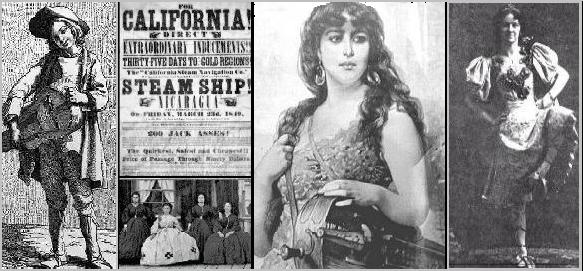

An English decree from 1651 that travelling musicians had proper licenses stated: “The hurdy-gurdyists, both men and women should be removed completely so that we no longer need to see their vulgar and disorderly talk and gestures which the travelling musicians delight in cultivating together with other impertinances.” It fell from popularity, then re-emerged as a novelty among the nobility in the 17th and 18th centuries, and older guitars and lutes were sometimes rebuilt into hurdy-gurdys. Haydn wrote two concerti for the hurdy-gurdy, Mozart included it a piece or two and Schubert’s hinted at it in “Der Leiermann.”
Then, there was the other definition of a “Hurdy Gurdy.” Poor Hessian farmers in the 1820s made wooden brooms and fly-whisks during the long cold winters to sell in summer at nearby markets, and the sales expanded into other German cities and town and eventually even to France and England.
They found that their wares sold better if they brought along pretty dancing girls who played the Hurdy Gurdy. This gave birth to a sort of 19th century “pimp” who would convince the parents of these young girls to allow them to travel with him and entertain in dance halls on the promise they would send a fair portion of their earnings home. The poverty-struck parents agreed, and the “Hurdy-Gurdy girls” and “Hessian Broom Girls” ended up all over the globe. Many travelled out to gold-rush California or Alaska, while others ended up in the Australia mining regions. By 1865, laws were passed in Germany to prevent the practise of enticing young girls into what was considered a debauch life, and the practise, at least in public, died out.
In the 1870s, the editor of a Western newspaper called the deeply appreciated diversions “wandering daughters from the sunny banks of the Oder, the Elbe, and the Rhine.” Most were jovial escorts, what a cowboy or miner might think of as a drinking buddy with breasts. Saloon and dance hall women were not generally prostitutes, although the occasional girl slipped into it due to hardship, abuse, drug addiction or alcoholism.
Peer pressure and saloon rules tended to keep the men in line, and they generally treated the girls respectfully and even bought them gifts. On top of that, customers were sold dance tickets for 75¢ or even a $1.00 which the girls split with the saloon owner, and the girls also made a commission from the drinks that they sold. At certain points during the evening, the music would stop and the girls would steer the men to the bar. After customer bought the girls shot glasses of tea or colored sugar water disguised as high priced whiskey, the dancing would begin again, and the gent got to dance with the girls for the five to fifteen alloted minutes. A girl might average 50 dances a night, which meant a lot of money and kept the girls protected as a valuable asset.
During the Gold Rush, dance halls spread rapidly around mining camps. In some mining towns, the hurdy houses had balconies where a rich prospector could sit and watch the girls below, sometimes showering his favorite dancer with gold dust or try to drop gold nuggets into the Hurdy’s bosom.
Except in German beer halls, where the wives or daughters of owners worked, there was generally not a “respectable” female presence in 19th century saloons. Before the Hurdies came, miners had to make do with all-male amusements and often had stag dances in the saloons, the “ladies” being represented by men with a white handkerchief tied about their arms. They danced the galop, a varsouvienne, waltz, mazurka, do-si-do, or schottische.
Four girls made up a typical Hurdy company, and they were generally accompanied by a married couple, often with children of their own, who chaperoned them at all times, plus two or more musicians who usually played an accordion. These girls traveled on foot from camp to camp, and remained in one camp as long as they made good money or married, which was common. There was great joy at their arrival.
The dance hall women provided entertainment and companionship for men, especially in the far west which at the time had a predominantly male population, in some areas over 90%. Arrayed in their scandalous calf length skirts, they wore kid boots that often sported tassels, and stockings held up by garters. Their shirts were low cut and showed cleavage and they also wore make-up and often dyed their hair. The Hurdy Gurdy girls are an interesting part of the history of the American old west.
| Bonnie Are The Hurdies, O! | ||
|
There’s naught but care on ilka han,’
On every hour that passes, O! An’ Sawney, man, we hae nae chance To spark amang the lasses, O! Bonnie are the hurdies, O!
A warldly race that riches chase,
Last summer we had lassies here
|
There was Kate and Mary, blithe and airy,
And dumpy little Lizzie, O! And ane they ca’d the Kangaroo, A strappin’ rattlin’ hizzy, O! They danced at night in dresses light,
The dollar was their only love,
They left the creek wi’ lots o’ gold,
|
|
| “Bonnie Are The Hurdies 0!” by W. Sawney from the July 23, 1866 Cariboo Sentinel was a reworking of “Green Grow the Rashes, 0” which Robert Burns reworked in 1784 from an even older tune, “Rustic song,” which was first printed 1549. |